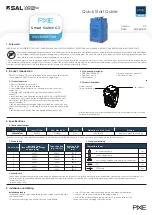
Section 13: Model 3750 multifunction control card
Series 3700A Switch and Control Cards Reference Manual
13-6
3700AS-909-01 Rev. B / December 2011
Sourcing current to an external load
When outputs are set to logic high, they are capable of sourcing up to 10 mA of current and
maintaining a logic high state on the output. The outputs are protected against short circuits to
ground, but do not generate a fault condition if that occurs. The logic high outputs cannot sink current.
Sinking current and overload protection
When outputs are set to logic low and the output current becomes greater than about 500 mA, the
output driver limits the current at this level to restrict internal power dissipation. The Model 3750
detects this condition and generates a fault condition. The action following the fault condition is
determined by the auto protect mode state. Do not allow such current limit situations to exist in the
normal course of operation. Ensure that the external circuits limit the sinking current to a level within
the specifications.
Using auto protect mode
Built into the Model 3750 is the capability to auto protect the digital outputs. It is a selectable mode
(turned on by default) that protects the outputs by re-configuring them as inputs in order to limit the
stresses on both the external driving circuits and the internal output drivers.
Using external user logic circuits
L5 V is available and is intended for powering logic circuits. It is fused to prevent damage if
the output is shorted. The fuse is a resettable type whose recovery time depends on ambient
temperature. The higher the temperature, the longer it takes to reset. The maximum time presented in
the Model 3750 specifications is for a "worst case" scenario. Checking for +5 V after the fault has
been cleared avoids this lengthy delay in most cases.
Programming overview
There are five banks of 8 bits each on the Model 3750 card. The following examples apply to the card
as shipped, as the jumpers are set to the position that pulls them up internally to +5 V.
To read the banks
After power up, the digital I/O default state is configured as digital input. Use the channel.setmode()
command to explicitly set a bank as inputs:
channel.setmode("1005", channel.MODE_INPUT)
To read the eight bits associated with bank 5, use the channel.read() command:
chan5 = channel.read("1005")
To read up to four banks at the same time, use the optional
width
parameter. For example, to read
four banks at the same time, use:
big_read = channel.read("1001", 4)
This causes banks 1, 2, 3, and 4 to be read at the same time and returned. The specified channel to
the command is returned in the least significant byte and subsequent ascending channels are
returned in the adjacent bytes. For example, if
big_read
contains the value 1144201745
(hexadecimal value of 44332211), this means that bank 1 was 17 (hexadecimal 11), bank 2 was 34
(hexadecimal 22), bank 3 was 51 (hexadecimal 33), and bank 4 was 68 (hexadecimal 44).
















































